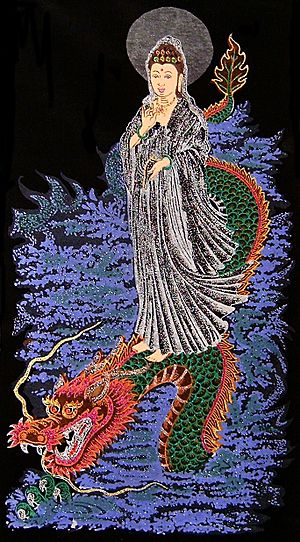Guan Yin facts for kids
Quick facts for kids Guan Yin |
|||||||||||||||||||||||||||||||
|---|---|---|---|---|---|---|---|---|---|---|---|---|---|---|---|---|---|---|---|---|---|---|---|---|---|---|---|---|---|---|---|

|
|||||||||||||||||||||||||||||||
| Chinese name | |||||||||||||||||||||||||||||||
| Traditional Chinese | 觀音 | ||||||||||||||||||||||||||||||
| Simplified Chinese | 观音 | ||||||||||||||||||||||||||||||
|
|||||||||||||||||||||||||||||||
| Full Chinese name | |||||||||||||||||||||||||||||||
| Traditional Chinese | 觀世音 | ||||||||||||||||||||||||||||||
| Simplified Chinese | 观世音 | ||||||||||||||||||||||||||||||
| Literal meaning | "[The One Who] Perceives the Sounds of the World" | ||||||||||||||||||||||||||||||
|
|||||||||||||||||||||||||||||||
| Burmese name | |||||||||||||||||||||||||||||||
| Burmese | ကွမ်ယင်မယ်တော် | ||||||||||||||||||||||||||||||
| Vietnamese name | |||||||||||||||||||||||||||||||
| Vietnamese | Quan Âm Quán Thế Âm |
||||||||||||||||||||||||||||||
| Hán-Nôm | 觀音 觀世音 |
||||||||||||||||||||||||||||||
| Thai name | |||||||||||||||||||||||||||||||
| Thai | กวนอิม | ||||||||||||||||||||||||||||||
| Korean name | |||||||||||||||||||||||||||||||
| Hangul | 관음 관세음 |
||||||||||||||||||||||||||||||
| Hanja | 觀音 觀世音 |
||||||||||||||||||||||||||||||
|
|||||||||||||||||||||||||||||||
| Japanese name | |||||||||||||||||||||||||||||||
| Kanji | 観音 觀音 観世音 観音菩薩 観自在 |
||||||||||||||||||||||||||||||
|
|||||||||||||||||||||||||||||||
| Sinhala name | |||||||||||||||||||||||||||||||
| Sinhala | නාථ දෙවියෝ | ||||||||||||||||||||||||||||||
| Tibetan name | |||||||||||||||||||||||||||||||
| Tibetan | སྤྱན་རས་གཟིགས | ||||||||||||||||||||||||||||||
Guan Yin (also spelled Kwan Yin) is a very important figure in Buddhism. She is known as the Bodhisattva of kindness and mercy. Her full name, Guanshiyin, means "The One Who Hears the World's Cries." She is loved by many people in both Eastern and Western cultures.
Guan Yin can appear in many different forms. She can be seen as male or female, and as an adult or a child. She can even appear as a human or a non-human. This allows her to help people in many ways.
Guan Yin's Names in Asia
Guan Yin is known by different names in various Asian countries:
- In Macau, Hong Kong, and southern China, she is called Kwun Yum or Kun Yum.
- In Japanese, she is called Kannon (観音) or Kanzeon (観世音).
- In Korean, she is known as Gwan-eum (관음) or Gwanse-eum (관세음).
- In Thai, her names include Kuan Im (กวนอิม) and Phra Mae Kuan Im (พระแม่กวนอิม).
- In Indonesian, she is called Kwan Im or Dewi Kwan Im. The word Dewi means "Goddess." Sometimes she is called Mak Kwam, which means "Mother Kwan Yin."
- In Vietnamese, people call her Quan Âm or Quán Thế Âm Bồ Tát.
- In Khmer, she is called "Preah Mae Kun Ci Iem".
- In Tibet, she is known as Chenrezig. The Dalai Lama is often seen as a modern form of Chenrezig.
How Guan Yin is Shown
The Threefold Lotus Sutra is an important Buddhist text. It says that Guan Yin is a Bodhisattva who can take any form. She can change into a male, female, adult, or child. She can even become a human or a non-human. This is so she can teach the Dharma (Buddhist teachings) to everyone. The Threefold Lotus Sutra mentions that Guan Yin has 33 different forms. Seven of these forms are female.
In the Song Dynasty (960–1279 AD), Guan Yin was often shown as male. Later, images and statues began to show her as both male and female. This was because of the Lotus Sutra. Around the 12th century, Guan Yin started to be shown mostly as female. This is because she represents kindness and compassion. She is also seen as a mother-goddess and a protector of mothers and sailors. Today, Guan Yin is often shown as a beautiful young woman in white robes. This image comes from an older form called Pandaravasini.
In China, Guan Yin is usually shown as young and beautiful. She wears white robes and a necklace fit for royalty. In her left hand, she holds a vase with the elixir of immortality. In her right hand, she holds a willow branch. Guan Yin also wears a crown with an image of Amitabha Buddha.
Guan Yin is a key character in Journey to the West. This is one of the four most famous Chinese stories. It tells the story of a monk named Chen Hui from the Tang Dynasty. He goes on a long journey to India with three companions. Guan Yin helps him by recruiting Monkey King (Sun Wukong) to join the journey. She also helps by getting Zhu Bajie (Pigsy) and Sha Wujing (Sandy) to protect Chen Hui.
Related Topics
Images for kids
-
Shrine to a Tang Dynasty (896) carved stone statue of the Thousand-Armed Guanyin (Chinese: Qianshou Guanyin) in Shengshui Temple (內江聖水寺) in Neijiang, Sichuan, China
-
Amoghapāśa Lokesvara (Japanese: Fukūkenjaku Kannon) with devas Brahma and Indra on either side dated to late 8th century) located at Tōdai-ji, Nara, Japan.
-
Chapter 25: The Universal Gateway of Avalokiteśvara Bodhisattva (Published in Edo period)
-
Guanyin as a male bodhisattva. Eleven faced Ekādaśamukha form. Japan, 12th century
-
Shrine to a statue of Ekādaśamukha, or the Eleven-Headed Guanyin (Shíyīmiàn Guānyīn) in the Drum Tower of Qita Temple (七塔寺) in Yinzhou, Ningbo, Zhejiang Province, China
-
This wooden statue of Quan Âm Nghìn Mắt Nghìn Tay (Quan Am Bodhisattva with 1000 eyes and 1000 hands) was fashioned in 1656 in Bắc Ninh Province, northern Vietnam. It is now located in the History Museum in Hanoi.
-
Chinese porcelain statue depicting Guanyin, Yuan Dynasty (1271–1368 AD)
-
Statue of Ekādaśamukha or the Eleven-Headed Guanyin (Shíyīmiàn Guānyīn) in Bukenqu Guanyin Yard [zh] (不肯去觀音院) in Putuoshan, Zhoushan, Zhejiang Province, China
-
A Chinese Ming dynasty porcelain figure of Guanyin.
-
Shrine to a statue of Ekādaśamukha, or the Eleven-Headed Guanyin (Shíyīmiàn Guānyīn) in Huayan Temple (華嚴寺); Datong, Shanxi Province, China
-
A Chinese folk religion temple devoted primarily to the goddess Guanyin, in Lahad Datu, Sabah, Malaysia.
-
Blessed Virgin Mary, disguised as Kannon, Kakure Kirishitan, 17th century. Salle des Martyrs, Paris Foreign Missions Society.
-
Chinese Madonna. St. Francis' Church, Macau.
See also
 In Spanish: Guan Yin para niños
In Spanish: Guan Yin para niños

















